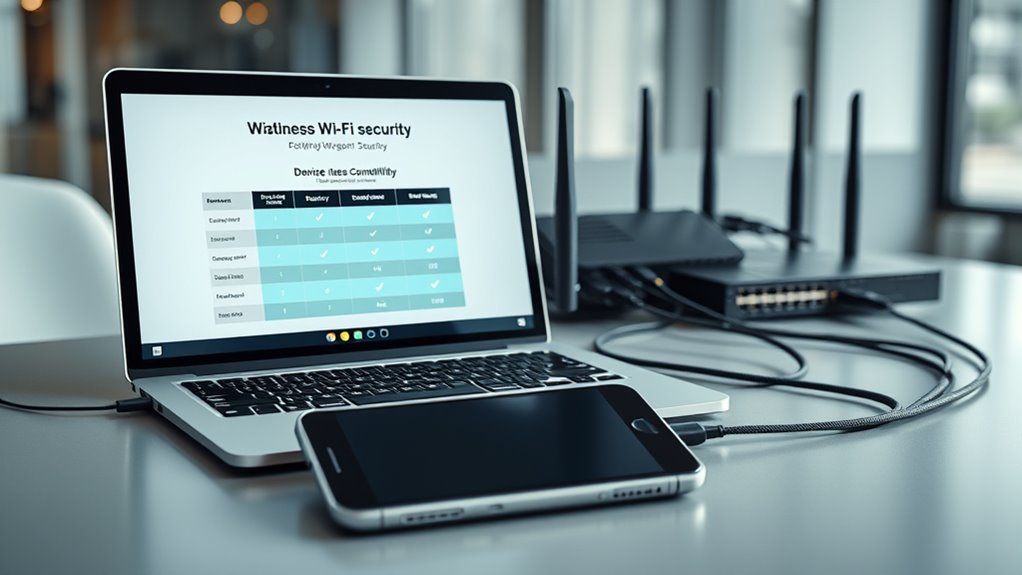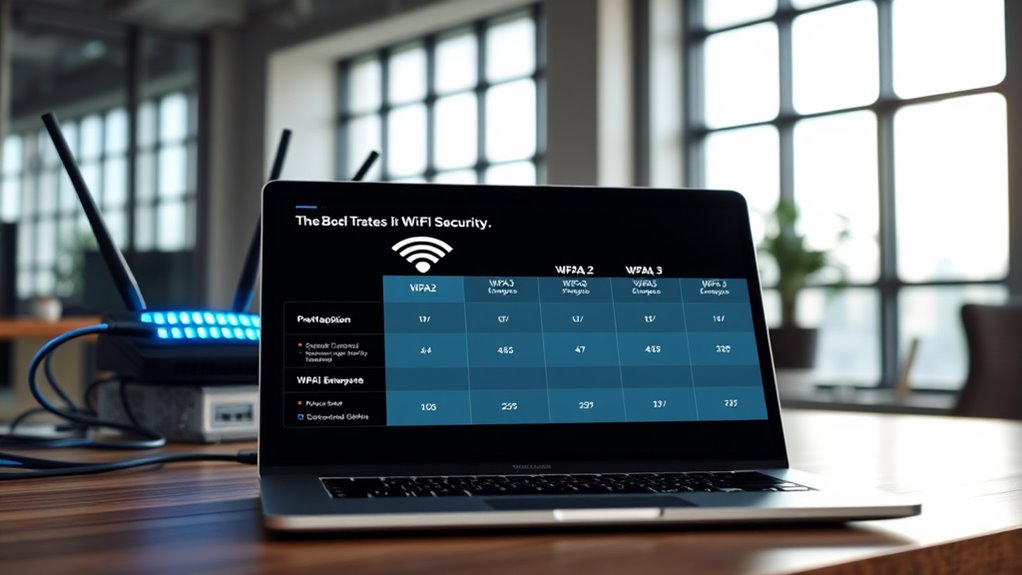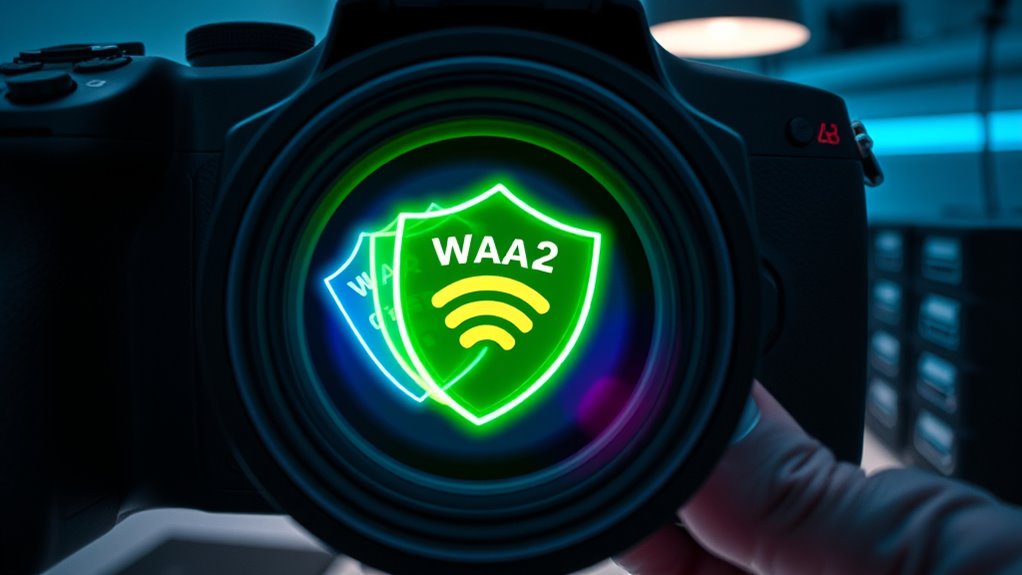If you want the best Wi-Fi security, WPA3 or WPA3-Enterprise are your top choices because they use stronger encryption, like AES-GCM, and better protect against offline password attacks with improved authentication methods like SAE. WPA2 remains widely supported and simple to implement but is more vulnerable to attacks like KRACK. For high-security environments, WPA3-Enterprise offers robust protection with mutual authentication. To make the right decision, consider your device compatibility and security needs as you explore further.
Key Takeaways
- WPA3 offers stronger encryption, improved password protection, and resistance to offline attacks compared to WPA2.
- WPA3-Enterprise provides enterprise-grade security with 192-bit AES and mutual authentication, ideal for high-security environments.
- WPA2 is widely supported and suitable for most home networks, but it is vulnerable to KRACK attacks and weaker against modern threats.
- Transition modes in WPA3 allow coexistence with WPA2, enabling gradual upgrades without network disruption.
- Choose WPA3 or WPA3-Enterprise if device support is available; otherwise, WPA2 remains a practical option with enhanced security measures.
Overview of Encryption Algorithms and Data Protection

Encryption algorithms are the backbone of Wi-Fi security, ensuring that data transmitted over your network stays private and protected from eavesdroppers. WPA2 uses AES with CCMP, offering strong data protection and integrity. WPA3 upgrades to AES in Galois/Counter Mode (GCM), providing even stronger encryption and built-in authentication for better confidentiality. For highly sensitive environments, WPA3-Enterprise employs 192-bit AES encryption, conforming to the CNSA suite. Unlike WPA2, WPA3 supports individualized encryption keys per device, boosting privacy. Both WPA2 and WPA3 require compatible hardware, but WPA3’s advanced encryption features need newer chipsets. These encryption algorithms make it markedly more difficult for attackers to decipher your data, maintaining your network’s security even against sophisticated threats.
Authentication Methods and Key Management

Authentication methods and key management are critical components that determine how securely devices connect to your Wi-Fi network. WPA2 relies on a pre-shared key (PSK) in personal mode or 802.1X authentication in enterprise mode, which can be vulnerable if passwords are weak or compromised. WPA3 improves this with Simultaneous Authentication of Equals (SAE), a more secure handshake resistant to offline dictionary attacks, and supports forward secrecy, ensuring past sessions stay private even if current keys are compromised. WPA3-Enterprise uses 802.1X with stronger encryption and mutual authentication, providing better control for sensitive environments. Key management in WPA3 ensures individualized encryption keys per device, enhancing privacy. Additionally, Kia Tuning techniques can optimize network performance, ensuring secure and efficient connections. Enhanced security protocols employed by WPA3 further strengthen your network against evolving threats. Overall, WPA3’s advanced authentication methods and dynamic key management notably bolster your network’s security compared to WPA2.
Password Security and Resistance to Attacks

WPA3’s use of SAE considerably improves password protection by making offline dictionary attacks much harder. Unlike WPA2, which offers little resistance to weak passwords, WPA3 helps prevent attackers from guessing your passphrase through precomputed lists. Additionally, WPA3 incorporates Enhanced Security Protocols that bolster overall network safety. These protocols also include forward secrecy, which ensures that even if a password is compromised in the future, past communications remain secure. Implementing a strong, complex password is essential to maximize the security benefits provided by WPA3’s advanced protocols, especially given the importance of robust password practices highlighted in Gold IRA Rollovers and related investment security strategies. Strengthening your password can significantly enhance your network’s protection against emerging threats.
SAE’s Password Protection
Have you wondered how WPA3 keeps your Wi-Fi passwords secure even if they’re weak? It uses SAE, or Simultaneous Authentication of Equals, replacing the vulnerable 4-way handshake from WPA2. SAE employs a “Dragonfly” handshake, making offline dictionary attacks nearly impossible. This means even if your password isn’t strong, SAE ensures your network stays protected. Unlike WPA2, which relies on pre-shared keys vulnerable to guessing, SAE creates unique, per-session keys. This strengthens privacy and reduces the risk of eavesdropping. Additionally, contrast ratio plays a vital role in how clearly images are rendered on projectors, directly impacting your viewing experience.
Offline Dictionary Resistance
WPA3’s use of SAE not only strengthens password protection but also considerably improves resistance against offline dictionary attacks. Unlike WPA2, which relies on a pre-shared key vulnerable to password guessing, SAE employs a simultaneous authentication method that makes offline guessing nearly impossible. When an attacker intercepts the handshake, they can’t test passwords offline because each authentication generates a unique, session-specific key. This means even weak passwords are less likely to be cracked without an active connection, reducing the risk of dictionary attacks. Additionally, WPA3’s protocol ensures that attackers can’t glean information to refine their guesses, making brute-force and dictionary attacks markedly less effective. Password complexity plays a crucial role in overall network security, and WPA3’s improvements help mitigate risks associated with weak passphrases. Overall, this improvement enhances your network’s security, especially if your passphrase isn’t complex. Enhanced security protocols further bolster WPA3’s defenses against various attack vectors.
Weak Password Vulnerabilities
Are weak passwords putting your Wi-Fi network at risk? If your passphrase is simple or common, attackers can easily guess or crack it using brute-force or dictionary attacks, especially on WPA2 networks. WPA3 improves this by making offline dictionary attacks harder with SAE, but weak passwords still pose a threat. Strong, complex passwords remain essential for all security protocols. Here’s a comparison:
| WPA Version | Password Security Strength |
|---|---|
| WPA2 | Vulnerable to guessing and offline attacks |
| WPA3 | Resistant to offline dictionary attacks |
| WPA3-Enterprise | Highly secure; uses 192-bit encryption |
| All Versions | Strong passwords are critical for safety |
| Transition Mode | Allows gradual upgrade, still vulnerable if password is weak |
Using complex, unique passwords considerably boosts your network’s defense against attacks. Additionally, understanding the importance of password management can help you maintain strong security practices across your devices.
Compatibility With Devices and Network Transition

Your devices’ support for different Wi-Fi standards impacts how smoothly you can upgrade your network. WPA3 introduces *interim* modes that let you run WPA2 and WPA3 devices together, easing in the *shift*. Keep in mind that not all devices support WPA3, especially older ones, which may require fallback options to maintain compatibility. Additionally, Ford Tuning techniques such as ECU remapping and performance upgrades exemplify how compatibility and gradual improvements are important in maximizing performance while ensuring stability. Ensuring device compatibility helps in creating a seamless transition without compromising security or functionality. As the integration of automation in networks advances, maintaining compatibility becomes even more crucial to avoid disruptions and vulnerabilities, especially with the increasing adoption of smart home devices and IoT technology.
Device Support Spectrum
Device support varies markedly across Wi-Fi security standards, impacting how smoothly networks can shift to newer protocols. WPA2 remains the most widely supported, compatible with virtually all modern and legacy devices, ensuring easy deployment. WPA3 introduces stronger encryption and authentication but requires newer hardware with updated chipsets, limiting support on older devices. Many consumer routers and IoT gadgets may not support WPA3 or WPA3-Enterprise, creating compatibility gaps. Transitional modes in WPA3 help facilitate a gradual upgrade, allowing WPA2 and WPA3 devices to coexist on the same network. However, full WPA3 support depends on both access points and client devices having compatible hardware. This spectrum of device support influences your upgrade strategies and the overall security posture of your network. Device compatibility is a crucial factor in determining the success of a network security upgrade, especially as hardware requirements evolve alongside security standards. Additionally, the backward compatibility features in transitional modes help bridge the support gap during the transition period, and understanding device support spectrum can help optimize your network’s security and functionality. Moreover, awareness of the security vulnerabilities associated with different standards can guide better decision-making for network protection.
Transition Mode Options
To support the gradual upgrade of Wi-Fi networks amid varying device capabilities, manufacturers have introduced options that allow older and newer devices to coexist seamlessly. Interim modes enable networks to support both WPA2 and WPA3 devices simultaneously, easing migration without immediate hardware upgrades. Many routers and access points offer WPA3 “mixed mode,” allowing WPA2 and WPA3 clients to connect concurrently. While WPA3 isn’t fully backward compatible due to different authentication methods, intermediary modes bridge this gap, ensuring compatibility. This flexibility helps organizations and consumers upgrade at their own pace, avoiding disruptions. Additionally, security enhancement features in WPA3 provide stronger protections compared to WPA2, making the transition beneficial beyond just device compatibility. New firmware updates are often required for devices to utilize WPA3 features fully. These options provide a practical way to enhance security gradually while maintaining broad device support during the transition, especially as tuning of Wi-Fi settings becomes increasingly important in complex network environments. Moreover, compatibility considerations are crucial for ensuring all devices function properly during the transition period, and understanding Gold IRA options can help diversify your investment portfolio during economic changes.
Typical Deployment Scenarios and Use Cases

Different Wi-Fi security protocols are suited to various deployment scenarios based on security needs and device compatibility. For home use, WPA2-Personal remains common due to its broad support and ease of setup. If you want stronger security for newer devices, WPA3-Personal offers enhanced protection, especially when passwords are weak. In corporate environments, WPA2-Enterprise provides per-user authentication, ideal for managing multiple users securely. High-security sectors like finance or government benefit from WPA3-Enterprise’s advanced encryption, forward secrecy, and strict compliance. Additionally, the availability of regional legal resources can influence the implementation of security protocols in different areas. Key deployment considerations include:
- Home networks: WPA2-Personal for simplicity and compatibility
- Small businesses: transitional mode with WPA3-Personal for gradual upgrade
- Large enterprises: WPA3-Enterprise for maximum security and user control
Common Vulnerabilities and Security Limitations

Despite advancements in Wi-Fi security protocols, vulnerabilities and limitations still pose significant risks. WPA2’s main weakness is the KRACK attack, which exploits its 4-way handshake, allowing attackers to reinstall session keys and intercept data. It also offers no protection against offline password guessing, making weak passphrases vulnerable. WPA3 improves security with stronger encryption and protections against offline attacks, but adoption is limited by hardware support. Not all devices support WPA3, especially older or IoT devices. Additionally, improper configuration or weak passwords can undermine WPA3’s benefits. WPA3-Enterprise offers enhanced security but requires compatible infrastructure, which may not be feasible everywhere. These vulnerabilities highlight that no protocol is entirely immune, emphasizing the need for vigilant security practices and regular updates.
Hardware Requirements and Future Proofing

WPA3’s enhanced security features require newer hardware with updated chipsets that support advanced encryption algorithms like Galois/Counter Mode (GCM) and individualized encryption keys. Without compatible hardware, devices can’t fully benefit from WPA3’s protections, making upgrades essential for future-proofing your network. Keep in mind:
- Many older routers and devices lack WPA3 support, limiting upgrades
- Some hardware may only support transitional modes, enabling mixed WPA2/WPA3 networks
- Upgrading hardware ensures compatibility with new security standards and improved performance
Investing in compatible devices now helps you stay protected against evolving threats and ensures your network remains secure as standards advance. While initial costs may be higher, future-proofing hardware prevents the need for frequent replacements.
Benefits and Challenges of Upgrading to New Standards

Upgrading to newer Wi-Fi standards like WPA3 offers significant security benefits, such as stronger encryption, better privacy protections, and resistance to common attacks. However, this changeover presents challenges. Not all devices support WPA3, requiring hardware updates or transitional modes, which can complicate deployment. Compatibility issues may cause connectivity problems with legacy devices, leading to frustration and potential security gaps if fallback options are poorly managed. Additionally, implementing WPA3’s advanced features demands proper configuration and user awareness; misconfigurations can undermine security gains. Cost is another consideration, especially for organizations needing to upgrade multiple access points or equipment. Despite these challenges, the enhanced protection against attacks like KRACK and offline password guessing makes upgrading a worthwhile investment for future-proofing your network’s security.
Selecting the Right Wi-Fi Security for Your Needs

Choosing the right Wi-Fi security depends on your specific needs, device compatibility, and risk level. If simplicity and broad device support matter, WPA2 is suitable. For enhanced security on newer devices, WPA3 offers stronger encryption and protection against common attacks. For organizations handling sensitive data, WPA3-Enterprise provides advanced features like 192-bit encryption and forward secrecy. Consider these factors:
- Compatibility with your devices and network infrastructure
- The level of security required for your environment
- Ease of deployment and future-proofing your network
If you have legacy devices, transitional modes allow mixed WPA2 and WPA3 support. Assess your security risks and device capabilities to select the best option that balances protection, usability, and scalability.
Frequently Asked Questions
Can WPA3 Be Used With Older Devices Lacking Support?
WPA3 can’t be used directly with older devices lacking support because it requires newer hardware to access its advanced security features. However, you can enable transitional modes on compatible routers, allowing WPA3 and WPA2 devices to connect simultaneously. This setup provides some security benefits for WPA3-capable devices while maintaining compatibility with legacy hardware. Keep in mind, full WPA3 security features won’t be available to devices without support.
Is WPA3 Backward Compatible With WPA2 Networks?
No, WPA3 isn’t backward compatible with WPA2 networks by default. You’ll need to use transitional modes, which allow WPA3 devices to connect to WPA2 networks, but full compatibility isn’t automatic. If your devices support WPA3, you can enable these modes, but older devices that only support WPA2 won’t benefit from WPA3’s enhanced security features unless your network hardware explicitly supports the transitional setup.
What Is the Real-World Impact of Wpa3’s Increased Encryption?
With WPA3’s increased encryption, your Wi-Fi network becomes markedly more secure against eavesdropping and cyberattacks. It protects your data with stronger algorithms like GCM, making it much harder for hackers to intercept or decrypt your information. This means your personal, financial, and work-related data stays private, even if someone tries to exploit vulnerabilities. Overall, WPA3 offers peace of mind by ensuring your wireless connection is resilient against current and future threats.
Are There Additional Costs to Upgrade to Wpa3-Enabled Hardware?
Upgrading to WPA3-enabled hardware is like planting a new seed—there’s a cost involved. You might face expenses for newer routers, access points, or IoT devices supporting WPA3. Some older equipment may need replacement, and setup could require professional help, adding to costs. However, these investments boost security, future-proof your network, and reduce vulnerabilities, making the initial expense worthwhile for long-term peace of mind.
How Does WPA3 Improve Privacy for Individual Users?
WPA3 enhances your privacy by assigning unique encryption keys to each device, making it harder for others to monitor your traffic. It also replaces shared passphrases with individualized keys, preventing traffic analysis. Additionally, WPA3‘s forward secrecy guarantees past communications remain secure even if your current password is compromised. These features work together to protect your data and online activities from eavesdropping and malicious attacks.
Conclusion
So, now that you know the ins and outs, remember: choosing Wi-Fi security is like picking a superhero cape—looks matter, but the real power lies in the protection. Whether you go for WPA2’s trusted cape or embrace WPA3’s shiny new armor, just don’t forget that the true security magic happens when you stay vigilant. After all, even the best encryption can’t save you from a careless click—so choose wisely, hero.









